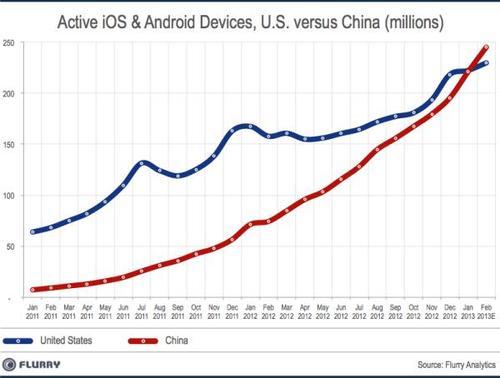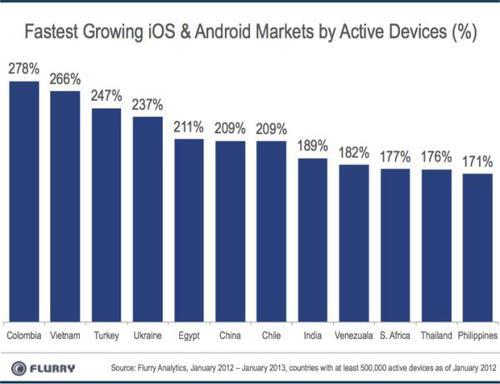Just days into the Chinese New Year (Year of the “Snake” for anyone keeping track), China has passed the U.S. to become the world’s top country for active Android and iOS smartphones and tablets. This historic milestone takes place a year after Flurry first reported that China had become the world’s fastest growing smart device market. Since then, it took China’s rapidly growing middle class just twelve months to close the gap on the U.S.
For this report, Flurry uses its entire data set, tracking more than 2.4 billion anonymous, aggregated application sessions per day across more than 275,000 applications around the world. Flurry estimates that it reliably measures activity across more than 90% of the world’s smart devices.

Reviewing the chart shows that China and the U.S. had roughly the same active smart device installed base in January 2013, 222 million in the U.S. versus 221 million in China. We use a model to project the final February 2013 installed base for each country based on historical growth trends as well as the number detected devices per country through the first half of February. Flurry estimates that by the end of February 2013, China will have 246 million devices compared to 230 million in the U.S.
We also conclude that the U.S. will not take back the lead from China, given the vast difference in population per country. China has over 1.3 billion people while the U.S. has just over 310 million. Considering that the U.S. has the world’s 3rd largest population, the only other country that could feasibly overtake China sometime in the future is India, with a population of just over 1.2 billion. However, with only 19 million active smart devices in India, China will not likely see competition from India for many years. Below, we show the top 12 countries by active iOS and Android installed base through the end of January 2013.

The chart shows that the U.S. and China each have more than five times the active installed base than that of the U.K., the world’s third largest market. Additionally, both China and the U.S. continue to see rapid device adoption. Year-over-year, compared to January 2012, the U.S. added 55 million new devices. However, in that same time, China added a staggering 150 million new devices. With its growth rate, China would have passed the U.S. earlier, except for the U.S.’s massive holiday season, which enabled the U.S. to hold off China for an additional two months.

The final chart in our analysis shows growth in the number of active smart devices per country, between January 2012 and January 2013. While China no longer leads the world in growth, it still commanded an impressive 209% rate of growth on top of a base of 71 million devices from January 2012. For this chart, Flurry selected countries that had a minimum of half a million devices as of January 2012. Countries that grew faster than China over the last year were Colombia, Vietnam, Turkey, Ukraine and Egypt. While the four BRIC countries are not all among the top 12 countries in terms of percentage growth (specifically, Brazil and Russia are not top 12 “growers”), all four are among the top 12 when calculating the number of net active devices added per market (i.e., Brazil +11.5 million, Russia +12.0 million, India +12.4 million, China +149.5 million).
In this new era of mobile computing, sparked by a confluence of powerful innovation across microprocessors, cloud storage and network speeds, Apple and Google have helped create the fastest adopted technology revolution in history, 10X faster than that of the PC Revolution and 3X that of the Internet Boom. And now, as the largest and fastest modernizing country in the world, Chinese consumers lead that revolution.